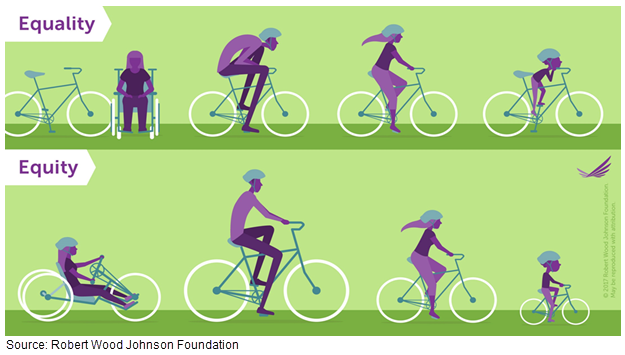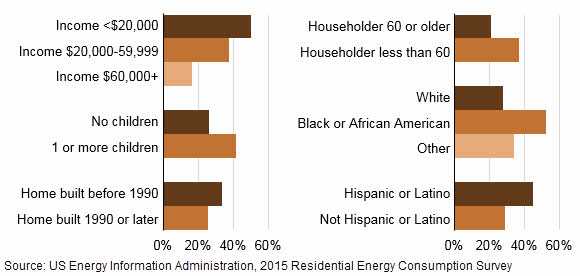What’s the difference between equality and equity?
Equality means treating everyone the same, regardless of their differences. In a utility context, this looks like providing all customers with the same programs and services. Equity means understanding people’s unique differences and giving them solutions tailored to address those differences, ensuring fairness and justice (figure 1). In a utility context, this looks like tailoring programs and services to customers’ specific needs.
Figure 1: Equality versus equity
Traditionally, utilities have approached customers as equals, offering them one-size-fits-all solutions. But understanding the differences among customers will help utilities serve them equitably.
Why should utilities care about energy equity?
People experience energy insecurity when they’re unable to meet their household’s energy needs, often due to financial hardship, substandard housing, and faulty appliances.
Energy-insecure customers have a high risk of falling into arrears. Once they do, utilities incur great expense related to:
- Pursuing collection both internally and through third-party vendors
- Disconnecting and reconnecting service
- Recovering, forgiving, or writing off debt
According to the results of the 2015 Residential Energy Consumption Survey by the US Energy Information Administration (EIA), one in three US households were energy insecure (figure 2). One in five households reported reducing or going without medicine or food to pay an energy bill. Eleven percent of households kept their homes at an unsafe or unhealthy temperature, and 14% received disconnection notices.
Figure 2: Energy insecurity by household characteristics
Before COVID-19, more than 37 million US households were energy insecure, according to Diana Hernandez, associate professor of public health at Columbia University. And that number has gone up because of the pandemic, which brought on economic turmoil and mass unemployment. You can read more about Hernandez’s insights in the Mother Jones magazine article Millions of People Can’t Afford to Keep Their Lights On. Now There’s a Pandemic. Hernandez also presented at the 2020 E Source Forum session Why it’s imperative to unify your clean-energy and energy equity initiatives.
How can utilities by part of the energy equity solution?
Work with the community. Energy-insecure customers may not be aware of or have easy access to the programs you offer. To help them, you need to get creative. Find ways to partner with vulnerable communities, local governments, environmental groups, regulators, housing authorities, and others. When community voices are engaged in the decision-making process, equity increases.
Find ways to partner with local community groups on energy equity initiatives. When community voices are engaged in the decision-making process, equity increases.
ATCO is a good example of partnering with the community, specifically Canada’s Indigenous communities. It highlights its Indigenous Relations and Community Development (PDF) in the 2019 ATCO Sustainability Report. Here are some of the results of ATCO’s partnerships:
- The utility helped generate over $220 million in economic benefits for Indigenous communities in 2019 through 50 different partnerships and joint ventures.
- Seven Indigenous communities purchased a 40% combined equity interest in a power line project, “providing [them] a stable source of income for years,” according to ATCO.
- With the help of Paul First Nation, a First Nations band government, ATCO installed natural gas infrastructure to 75 homes, providing clean-burning natural gas and improving air quality.
The City of Austin has a Community Climate Ambassadors program to start conversations about energy, transportation, food, and access to nature with historically underrepresented groups. The ambassadors will engage with BIPOC; youth; LGBTQ+ communities; immigrant, migrant, and refugee communities; union workers; people with disabilities; low-income communities; people experiencing homelessness; and people with records.
You can read about Manitoba Hydro’s community engagement on its Relationships & partnerships web page. Here are some examples of the utility’s work with its communities:
- The utility partners with the Manitoba Metis Federation, the official democratic and self-governing political representative for the Metis Nation’s Manitoba Metis Community, to improve the relationship between the organizations.
- The utility’s Northern Purchasing Policy has yielded $300 million in goods and service purchases from northern Indigenous businesses over the past 10 years.
- Moving forward, Manitoba Hydro is vowing to consult with Indigenous communities when planning future hydropower construction projects, incorporating traditional knowledge and cultural sensitivity into its environmental assessments.
Community involvement is essential to equitable demand-side management programs (DSM), which bring efficiency and savings to more customers and your utility. We’ve explained how you can incorporate equity into DSM programs in our report Using an equity lens to reach more customers with DSM programs (available to members of the Demand-Side Management Service).
Partner with other companies on equity initiatives. Dominion Energy Virginia is working with Prince George Electric Cooperative (PGEC) to bring broadband service to underserved rural areas. The utilities expect to give 4,500 Dominion Energy customers and 2,200 PGEC customers access to high-speed internet. You can read more about the partnership in Dominion Energy’s press release Thousands of Rural Virginians Could Get Broadband Access through Dominion Energy, Prince George Electric Cooperative Partnership.
Autoenroll vulnerable customers in money-saving programs. Seattle City Light and Seattle Public Utilities (SPU) automatically enroll income-eligible customers into the Utility Discount Program. Through the program, customers receive a 60% discount on their City Light electricity bills and a 50% discount on their SPU bills (water, sewer, garbage). Here’s how it works: The utilities work with Seattle Housing Authority to identify vulnerable customers. The utilities then autoenroll those customers in the Utility Discount Program, and the city sends a letter notifying them about their program enrollment. Customers can remain in the program for up to five years or opt out if they prefer.
Provide customers with easy-to-use resources. In April, the City of Austin launched a bilingual website, AustinBillHelp.com, to help Austin Energy and Austin Water customers apply for the city’s Emergency Financial Assistance Plus 1 Program. The program is available to customers “if they, or a member of their household, have experienced a financial hardship, loss of job, or reduction in income related to COVID-19.”
Commit to a diverse and equitable workplace. Edison International and Southern California Edison announced a partnership with the American Association of Blacks in Energy to increase Black representation in the energy industry. The utilities are vowing to make change in their employment, leadership, business contracting, and workforce development. You can read more in the Edison International press release Edison Strengthens Commitment to Black Employees by Joining AABE Energy Equity Initiative. Pedro Pizarro, Edison International president and CEO had this to say:
Diverse, equitable and inclusive workplaces lead to better business decisions and an environment where every employee feels supported and empowered. That’s why we’re committed to developing a team that reflects the broad diversity of the customers and communities we serve and to creating an environment that reflects our values.
Give everyone access to clean energy. You have the chance to offer all customers a seat at the clean-energy table, especially those disproportionately affected by energy insecurity, including BIPOC, rural neighborhoods, and the elderly. You’re in a unique position to create tailored, holistic solutions that can help reduce greenhouse gas emissions while also improving energy equity.
Need more ideas on how to help your vulnerable customers?
You can find more suggestions in our report What you can do now to help your vulnerable customers make it through COVID-19. It features a web conference we held on helping vulnerable customers during COVID-19.


